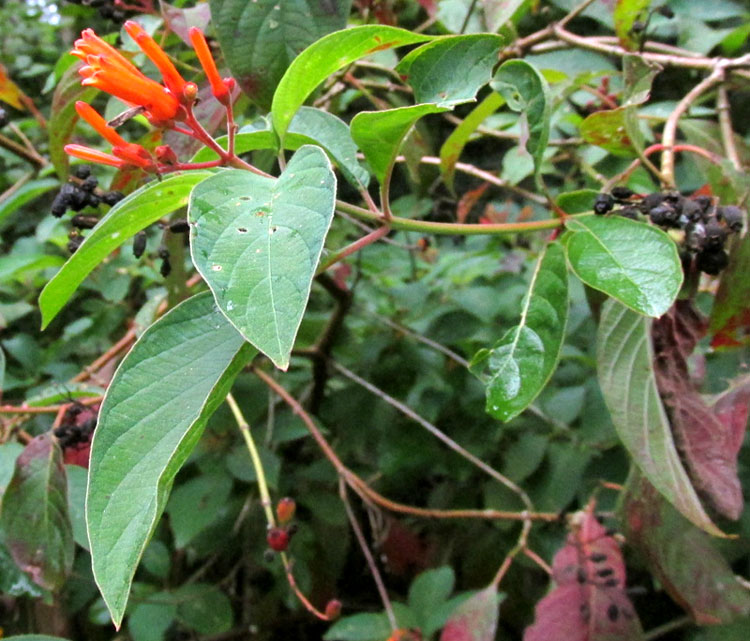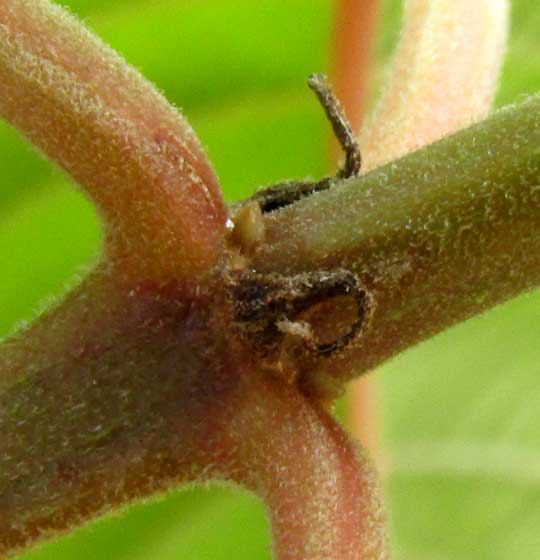Excerpts from Jim Conrad's
Naturalist Newsletter
entry from field notes dated October 7, 2022, taken about 3kms north of Gómez Farías, in woodland along the road approaching the bottom of Cañón el Azteca, Aztec Canyon, on the lower eastern slope of the Eastern Sierra Madres, El Cielo Biosphere Reserve, southern Tamaulipas state, MÉXICO; elevation about 300m (1000 ft), ± LAT. 23.04°N, LONG. 99.15°W
SCARLET-BUSH FLOWERING & FRUITING

Throughout humid tropical and subtropical America, from Florida south to Argentina, Scarlet-Bushes, HAMELIA PATENS, shown above, are among the most conspicuous and best-known bushes along roadsides, in abandoned fields, beside rivers and in forest clearings. Here in Mexico's Tamaulipas state, we're at the northern extreme of the species' distribution, and maybe that explains why the above plant is a little less robust looking and bears smaller flowering heads than those documented below, encountered farther south in the Yucatán. In the Yucatán we didn't get pictures of the Scarlet-Bush's fruits, but this plant bore mature ones beginning to dry out:

Atop each fruit there's a crown-like scar remaining from the flower's corolla which earlier was attached to the ovary's top. This indicates an "inferior ovary" -- as opposed to "superior" ones where the corolla arises below the ovary. In the American tropics, this field mark when combined with stems bearing two or more leaves at each node, is highly suggestive of the Coffee or Madder Family, the Rubiaceae, of which Scarlet-Bush is a member. The fruits technically are berries, meaning that they're simple, fleshy, and usually contain more than one seed, as seen below:

Hummingbirds and butterflies are attracted by the flowers, and birds certainly find the berries worth eating. I read that the fruits are edible for humans, but the ones I've tasted didn't inspire a second sampling. An interesting 1997 paper by Joseph Zurovchak entitled "Hamelia patens (Rubiaceae) Accelerates Fruit Maturation Rate in Response to Increased Fruit Removal" found that fruit removal, as by birds, caused the bush to speed up the maturation of its immature fruits. The species seems to go out of its way to be wildlife friendly.

Another diagnostic feature of the Coffee Family is its conspicuous stipules at stem nodes, one shown at the right. Usually they span across the stem between the tops of two adjacent leaf petioles. The stipule in that picture is shorter and somewhat different looking than the one photographed in the Yucatán. Also the parts are hairier, and the stem more squared in cross section. It's all just normal variations within the species.
Despite the species' weediness, it's attractive enough and so easy to grow in warmer climates that garden centers sell various forms, including variegated, dwarf and compact ones. Those marketed as "Dwarf Firebush," and which grow shorter and have leaves and flowers about half the size of those appearing on this page, are actually a natural variety of the species, Hamelia patens var. glabra. That variety is distributed from extreme southern Mexico south through Central America into northern South America. Ours is the typical Hamelia patens var. patens.
from the September 1, 2008 Newsletter written in Sabacché and issued from a ciber in nearby Tekit, Yucatán, MÉXICO
SCARLET-BUSH
All through tropical America, from Mexico to Paraguay, if you're traveling down a road where there's enough rainfall to support forest at least 20 feet high, the vegetation is weedy and the soil is halfway rich, if you see a much-branched shrub with rich-green, leafy branches ending in bright clusters of slender, red flowers, a good first bet is that the plant is HAMELIA PATENS, in English sometimes called Scarlet-Bush. That's one of our roadside beauties below:

One reason Hamelia patens is so conspicuous is because it has a long flowering season. As an evergreen shrub with herbaceous shoots up to 12 feet high, it just catches your attention again and again.
Hamelia patens is a member of the Coffee Family, the Rubiaceae, characterized by its stems bearing conspicuous, sharp-pointed stipules between opposite leaf bases, and the flowers being " inferior" -- corolla and stamens arising above the ovary, not at its base as in most flowers. Doña Martha, who calls the plant Kanán in Maya, has a high opinion of the species' medicinal value.
"Combine its leaves with those of Pomegranate and Guava, brew a tea from them, and you can cure skin sores by washing the skin with the tea. The tea is also good to wash around in your mouth when your mouth is inflamed and painful. And if you cut yourself, you heal better if you toast its leaves in the comal, grind them to a fine powder, and sprinkle the powder in the wound."
I have seen that people who really know about medicinal herbs typically combine two or more herbs together for a cure, seldom depending on a single plant. In this case it's interesting that while Scarlet-Bush and Guavas are native Tropical American plants, Pomegranates originated in Asia, so the blending of these three plant leaves by the Maya clearly came about after the Spanish Conquest.
It's also interesting that Maximino Martínez's Las Plantas Medicinales de México mentions different uses for the plant. There the plant is recommended for swollen, aching legs, and for removing "bad humors" from the body.
from the August 9, 2015 Newsletter issued from Yaxunah, 20kms southwest of Chichén Itzá; elevation about 300m (100ft), N20.538°, W88.678°, Yucatán, MÉXICO
SCARLET-BUSH FOR FOOT SORES
A friend with psoriasis lesions on her feet was approached by a local Maya man saying that he knew an herbal treatment that could cure it. Interested in traditional uses of medicinal plants, my friend jumped at the opportunity to have her feet treated with a genuine Maya cure.
Next morning when the man arrived to begin treatment he brought with him parts of two plant species. One was a leafy sprig of Scarlet-Bush. Back in 2008 when the previous entry about Scarlet-Bush was made, my camera couldn't focus very close but now we can better show some of Scarlet-Bush's field marks. For one thing, after the flowers are pollinated, the shrub's tubular, cylindrical corollas break loose, slide over the ovaries' long styles, and fall to the ground. Below, you can see a corolla that's come loose and now hangs at the style's tip:

In that picture notice that the ovary is mostly "inferior," with the calyx and corolla arising atop the ovary. Scarlet-Bush's leaves normally arise three to a stem node (2-5), and between the leaves there are long-pointed, somewhat triangular "stipules," as shown below:

Back in 2008 a Maya lady who seemed to know her medicinal plants, in the little Maya village of Sabacché bit south of Mérida, told us that Scarlet-Bush was medicinal, and she told how to brew a curing tea with leaves of Scarlet-Bush, Pomegranate and Guava. However, this local man with his foot-cure in Yaxunah didn't bring leaves of Pomegranate and Guava to brew with the Scarlet-Bush's leaves, but rather a foot-long leaf of Aloe Vera, called Sábila here. I was a little surprised that his Maya cure included Aloe Vera because that species is native to Africa (even Pomegranates are from Asia).
This time, for my friend's foot ailment, the Scarlet-Bush's leaves were cut into small pieces with a pocketknife, a little water was added, and the leaves in the bowl's bottom were crushed with his finger. Then the green jelly inside the aloe leaf was scraped into the bowl and the whole thing stirred up. The resulting runny emulsion was used to wash my friend's foot sores.
After several days of daily treatment my friend didn't see any improvement. One wonders whether if Pomegranate and Guava leaves had accompanied the Scarlet-Bush's leaves the treatment would have worked.
Whatever the case, the other day a Maya lecturer spoke to the group of US and Maya students attending the month-long ethnobotany workshop being conducted here at Yaxunah Community Center. After describing how the Maya use natural indicators to forecast the weather -- for example, how drought can be foreseen in the diminished flowering and fruiting of the Ceiba and Bec trees, and in details of the construction of the Altamira Oriole's pendulous nests -- the lecturer asked the three Maya students whether they'd been taught any of these techniques. Two students said that they'd heard nothing about them, while the third said he'd been taught some of the information, but not all.
During the following discussion of how such important knowledge is being lost, the student who'd learned a little from his family said this:
"My impression is that nowadays some of the old people in our community still know all these things. However, middle-aged people like our parents may have heard about the techniques, and sometimes try to use them, but often they get the details wrong and end up making mistakes. And then kids in our age-group don't hardly know any of the old knowledge."
That's what I've seen in the Maya communities I've stayed in, and maybe that explains why our Scarlet-Bush-leaf cure didn't produce the desired effects. Our volunteer healer had been middle-aged, so maybe he'd remembered that Scarlet-Bush leaves are good for skin sores, but never had learned the details that make the treatment work.